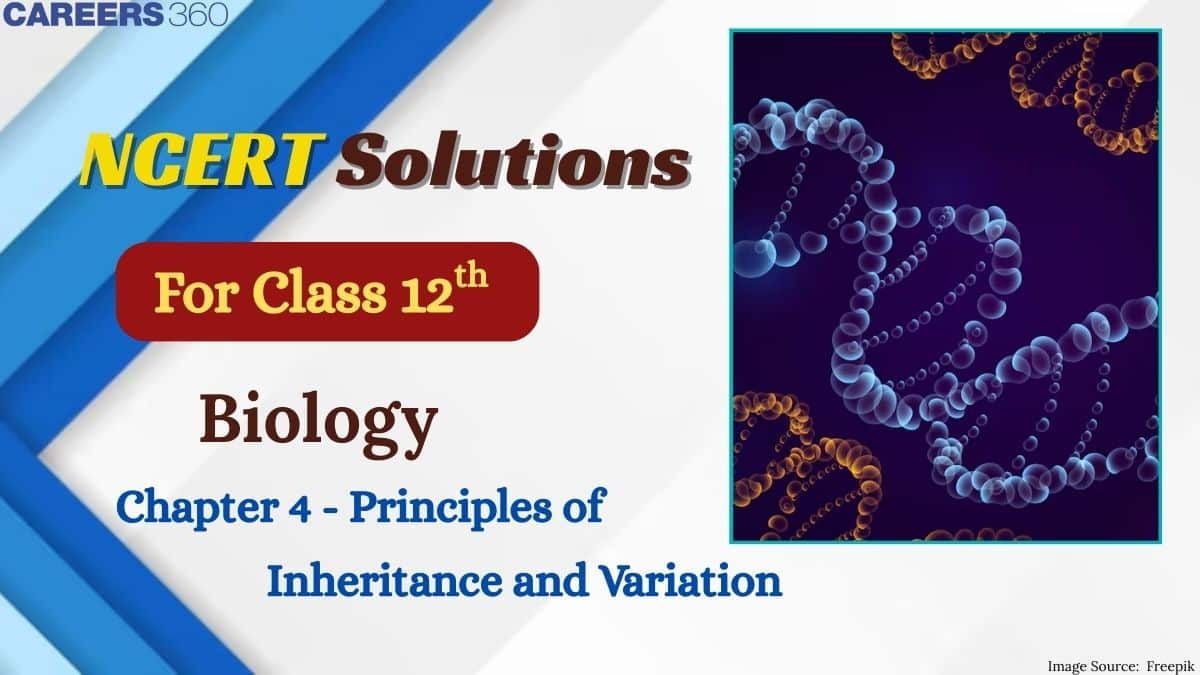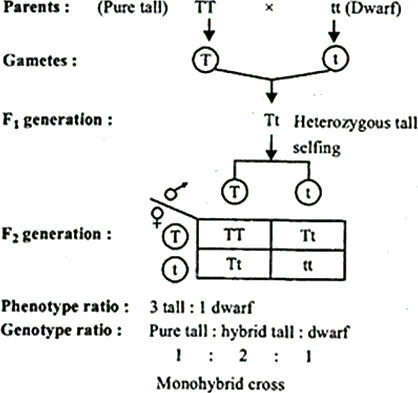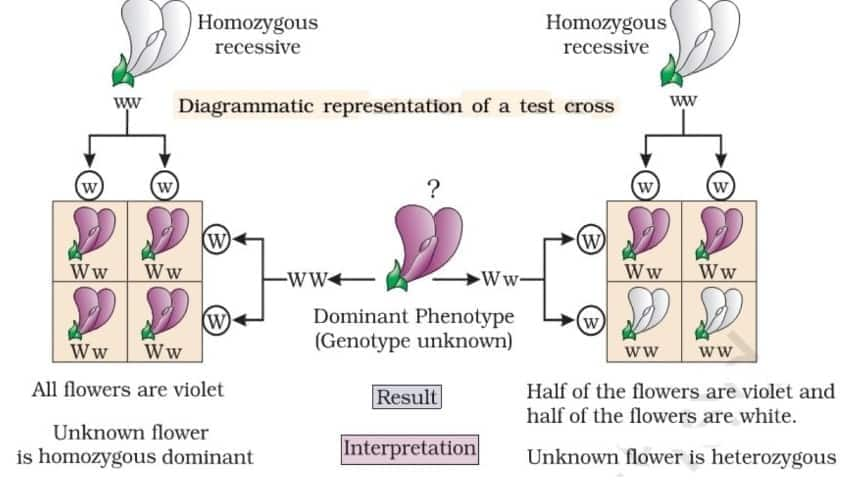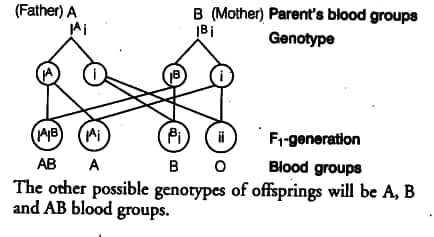NCERT Solutions for Class 12 Biology Chapter 4 Principles of Inheritance and Variation
The NCERT Solutions for Class 12 Biology, Chapter 4, "Principles of Inheritance and Variation," help students understand how traits are inherited by offspring from their parents. This chapter covers the fundamentals of genetics and heredity, including Mendel's laws, types of inheritance, sex determination, mutations, and genetic disorders. The NCERT solutions help students clarify their concepts and improve their performance in board exams as well as entrance exams, such as NEET.
This Story also Contains
- Download Principles of Inheritance and Variation NCERT Solutions PDF
- Class 12 Biology Chapter 4 Principles of Inheritance and Variation Solutions (Exercise Questions)
- Approach to Solve Principles of Inheritance and Variation Class 12 Question Answer
- Important Question of NCERT Class 12 Biology Chapter 4
- What Students Learn from Principles of Inheritance and Variation NCERT Solutions
- What Extra Should Students Study Beyond the NCERT for NEET?
- NCERT Solutions for Class 12 Biology: Chapter-Wise

The Class 12th "Principles of Inheritance and Variation" solution describes important terms such as dominant and recessive genes, monohybrid and dihybrid crosses. Hence, students are advised to go through the NCERT Solutions Class 12 Biology. By learn and practising these questions, they will be able to solve and understand questions in exams easily. The answers given in the solutions explain the concepts in a better way and help students build a strong foundation in genetics.
Download Principles of Inheritance and Variation NCERT Solutions PDF
Students can download the PDF from the link given below to make a quick and easy revision before exams. The Class 12 Biology Chapter 4 Principles of Inheritance and Variation question answers are explained clearly to help understand key topics. These solutions are based on the latest syllabus and are well explained in the NCERT Solutions for Class 12.
- NCERT Notes for class 12 biology Principles of Inheritance and Variation
- NCERT Exemplar for class 12 biology Principles of Inheritance and Variation
Class 12 Biology Chapter 4 Principles of Inheritance and Variation Solutions (Exercise Questions)
This chapter explains different principles of inheritance and variation in an easy way. To make learning easier, Class 12 Biology Chapter 4 Principles of Inheritance and Variation question answer are prepared according to the latest NCERT curriculum. Solving these questions regularly builds a strong base and boosts confidence for exams.
Q1. Mention the advantages of selecting a pea plant for the experiment by Mendel.
Answer:
The merits of choosing a garden pea (Pisum sativum) for experimentation by Mendel are:
-
Pea possesses numerous visible contrasting characters.
-
The duration of the life of pea plants is short, and they yield numerous seeds in a single generation.
-
Pea flowers are bisexual and exhibit self-pollination, with reproductive whorls being covered by the corolla.
-
It is not difficult to artificially cross-pollinate the pea flowers. The hybrids thus obtained were fertile.
Q2. Differentiate between the following
Answer:
|
Dominance |
Recessive |
|
Expressed in the presence of an allele |
Only expressed if the dominant is absent |
|
Functional enzyme produced |
Defective or non-functional enzyme |
(b) Homozygous and Heterozygous
Answer:
|
Homozygous |
Heterozygous |
|
Identical alleles (TT) |
Different alleles (Tt) |
|
One type of gamete |
Two types of gametes |
Answer:
|
Monohybrid |
Dihybrid |
|
One trait considered |
Two traits considered |
|
Tall vs. Dwarf pea plants |
Round/Yellow vs. Wrinkled/Green seeds |
Q3. A diploid organism is heterozygous for 4 loci. How many types of gametes can be produced?
Answer:
If a diploid organism is heterozygous at 4 loci, it implies it has four genes where it possesses two distinct alleles at each of the four loci.
We calculate the number of various gametes that can be formed by the formula 2n, where n represents the number of heterozygous loci.
Here, n = 4, thus the number of gametes = 24 = 16.
Thus, 16 different varieties of gametes can be formed.
Q4. Explain the Law of Dominance using a monohybrid cross.
Answer:
The Law of Dominance, as suggested by Mendel, is:
-
Traits are determined by factors (genes) that come in pairs (alleles).
-
In a heterozygous organism, one allele (the dominant allele) suppresses the expression of the other allele (the recessive allele).
-
The recessive allele is expressed only when it is in a homozygous state.
-
A monohybrid cross illustrates this law well. For instance, cross-pollinating a homozygous tall pea plant (TT) with a homozygous dwarf pea plant (tt):
-
P Generation: Tall (TT) x Dwarf (tt)
-
F1 Generation: All the offspring are heterozygous (Tt) and tall. The tall allele (T) is dominant to the dwarf allele (t), and therefore all plants have the tall phenotype, suppressing the dwarf trait.
-
F2 Generation: If the F1 generation (Tt) is self-pollinated, the F2 generation exhibits a 3:1 phenotypic ratio (3 tall: 1 dwarf). The dwarf trait re-emerges because some plants are now homozygous recessive (tt).
-
This re-emergence of the recessive trait in the F2 generation proves that the recessive allele existed in the F1 generation, but its expression was suppressed by the dominant allele.

In this cross, it can be seen that in the F1 generation, only tall plants were seen; no plant was a dwarf. However, in the F2 generation, the F1 progeny was self-crossed, three genotypes were observed, among these, the hybrids were showing the dominant trait.
Q5. Define and design a test cross.
Answer:
A test cross is a technique used to determine whether a person exhibiting a dominant phenotype is homozygous dominant or heterozygous for a particular character.
Definition: The cross between an F1 hybrid and its homozygous recessive parent is called a test cross.
Design:
-
Choose a person showing the dominant phenotype but having an unknown genotype (e.g., a tall plant might be TT or Tt).
-
Cross this person with a homozygous recessive person (e.g., a dwarf plant with the genotype tt).
Examine the offspring:
-
If all offspring have the dominant phenotype, the mystery parent was most likely homozygous dominant (TT).
-
If the offspring have a 1:1 ratio of dominant and recessive phenotypes, the mystery parent was heterozygous (Tt).

Answer:
Let's take one locus with alleles B (black coat colour, dominant) and b (white coat colour, recessive) in guinea pigs. A cross between a homozygous recessive female (bb) and a heterozygous male (Bb):
|
B |
b | |
|
b |
Bb |
bb |
|
b |
Bb |
bb |
-
Genotypes: 50% Bb (heterozygous), 50% bb (homozygous recessive)
-
Phenotypes: 50% black coat colour, 50% white coat colour
-
Ratio: The F1 progeny will show a 1:1 ratio of black coat colour to white coat colour.
Q7. When a cross is made between a tall plant with yellow seeds (TtYy) and a tall plant with green seeds (Ttyy), what proportions of phenotype in the offspring could be expected to be
Answer:
Let's perform the cross: TtYy x Ttyy
|
TY |
Ty |
tY |
ty | |
|
Ty |
TTYy |
TTyy |
TtYy |
Ttyy |
|
ty |
TtYy |
Ttyy |
ttYy |
ttyy |
From the Punnett square, we can determine the offspring phenotypes:
-
Tall and Yellow (T_Y_): TTYy, TtYy, TtYy (3)
-
Tall and green (T_yy): TTyy, Ttyy, Ttyy (3)
-
Dwarf and Yellow (ttYy): ttYy (1)
-
Dwarf and Green (ttyy): ttyy (1)
-
The genotypic ratio is 3:3:1:1
Hence, there will be plants showing three tall and green seed traits.
Answer:
(a) tall and green.
The proportion of tall and green offspring is 3/8 or 37.5%
(b) dwarf and green.
The proportion of dwarf and green offspring is 1/8 or 12.5%
Answer:
When two heterozygotes are crossed (e.g., AaBb x AaBb) and the two loci (A/a and B/b) are linked, the segregation of the phenotypic traits in the F1 generation of a dihybrid cross is not in the usual 9:3:3:1 ratio.
- Linkage: This is the physical linkage of genes on the same chromosome. Linked genes are inherited together.
- If the genes are linked (no crossing over), only the parental phenotypes will be seen in the offspring.
- If the genes are partially linked (crossing over has taken place), both parental and recombinant phenotypes will be seen, but the parental phenotypes will occur more often than the recombinant phenotypes.
- For instance, a Yellow body, white eyes, and a wild-type parent cross in Drosophila. Hence, they are co-inherited in progenies. Parental types and recombinant types are 98.7% and 1.3%, respectively.
Q9. Briefly mention the contribution of T.H. Morgan to genetics.
Answer:
Contribution of T.H. Morgan to the discipline of genetics:
-
Chromosomal Theory of Inheritance: Morgan, along with his co-worker, presented better evidence of genes on chromosomes rather than the chromosomal theory of inheritance.
-
Sex-Linked Inheritance: Morgan showed sex-linked inheritance by studying Drosophila melanogaster and exhibiting that there are certain characteristics that are linked with sex chromosomes.
-
Linkage and Recombination: Morgan described the phenomenon of linkage (genes on the same chromosome are inherited together) and recombination (crossing over produces new combinations of alleles).
-
Mapping of Genes: Morgan's group established techniques to map the relative positions of genes on chromosomes in terms of recombination frequencies.
Q10. What is pedigree analysis? Suggest how such an analysis can be useful.
Answer:
Pedigree Analysis:
Definition: Pedigree analysis refers to the examination of the pattern of inheritance of a certain trait in a family line. It entails mapping a family pedigree and following the presence of the trait in generations.
Usefulness:
-
Determining Inheritance Pattern: Pedigree analysis determines if a trait is dominant, recessive, sex-linked, or autosomal.
-
Risk Prediction: It is possible to use it to estimate the likelihood of future offspring inheriting a given genetic condition.
-
Genetic Counselling: Genetic counsellors employ pedigree analysis to counsel families regarding their risk of having children with genetic disorders.
-
Identification of Carriers: Pedigrees can be used to identify carriers of recessive genetic disorders.
Q11. How is sex determined in human beings?
Answer:
Sex determination in human beings is on a chromosomal basis:
- Human beings possess 23 pairs of chromosomes: 22 pairs of autosomes and 1 pair of sex chromosomes.
- Females possess two X chromosomes (XX).
- Males possess one X and one Y chromosome (XY).
- In meiosis, females give rise to eggs that all carry an X chromosome.
- Males give rise to sperm that are either X-bearing or Y-bearing.
- If a sperm carrying X fertilises the egg, the child will be female (XX). If a Y-bearing sperm fertilises the egg, the child will be male (XY).
Thus, the offspring's sex is determined by the sperm.
Answer:
If the child has an O blood group, then it is evident that the parents are heterozygous. Thus, the genotype of the father will be IAi, and that of the mother will be IBi. The child having blood group O will have genotype ii. The other children may have genotypes IAi (A blood group), IBi (B blood group), and IAIB (AB blood group).

Q13 . Explain the following terms with an example
Answer:
Codominance-
It refers to the phenomenon of two alleles lacking a dominant-recessive relationship and both expressing themselves in the heterozygous condition. In human beings, ABO blood grouping is controlled by gene I. The gene has three alleles I A, I B and i. One person may have any two of these three alleles. Among these alleles, I A, and I B are dominant over i. Alleles IA and IB. When I A and I B are present together, both express themselves because of co-dominance.
Answer:
Incomplete dominance-
Incomplete dominance is the phenomenon of neither of the two alleles being dominant, so that expression in the hybrid is a fine mixture or intermediate between the expressions of the two alleles. In snapdragon ( Mirabilis jalapa), there are two types of pure breeding plants, red-flowered and white flowered. On crossing the two, F1 plants possess pink flowers. On selfing them, F2 generation has 1red: 2pink: 1white. The pink flower is due to incomplete dominance
Q14. What is a point mutation? Give one example.
Answer:
-
Point Mutation: A mutation which is a change at one point or location in the DNA sequence. It is a single-base pair or a few-base pair change.
-
Example: Sickle cell anaemia. The disease is caused by a single base substitution in the gene for the beta-globin chain of haemoglobin. The GAG to GUG substitution at the sixth codon causes glutamic acid to be replaced by valine, leading to abnormal haemoglobin that causes red blood cells to develop sickle shapes.
Q15. Who proposed the chromosomal theory of inheritance?
Answer:
Sutton and Boveri in 1902 proposed the chromosomal theory of inheritance.
Q16. Mention any two autosomal genetic disorders with their symptoms.
Answer:
Sickle Cell Anaemia:
-
Genetic Basis: Autosomal recessive disease due to a mutation of the gene for beta-globin on chromosome 11.
-
Symptoms: Chronic anaemia, pain crises, fatigue, susceptibility to infection, retarded growth, and organ damage.
Down Syndrome:
-
Genetic Basis: Autosomal disease due to trisomy 21 (an extra copy of chromosome 21).
-
Symptoms: Intellectual disability, characteristic face (e.g., flat nose, slanted eyes), heart malformation, and other medical disorders.
Also, check the NCERT Books and the NCERT Syllabus here:
Approach to Solve Principles of Inheritance and Variation Class 12 Question Answer
To solve the questions effectively, one needs to understand the concepts first. The chapter has certain key terms, such as Mendel's laws, monohybrid and dihybrid crosses, mutation, and genetic disorders. Making notes of the chapter is important; students can do it by highlighting all the important points and terms. The Class 12 Biology Chapter 4 Principles of Inheritance and Variation question answer are written in simple language and include all necessary information. Students must practice the Class 12 Biology Chapter 4 Principles of Inheritance and Variation Solutions to have an overall idea of the chapter and build confidence before the exams.
NCERT Solutions for Class 12- Subject-wise
Important Question of NCERT Class 12 Biology Chapter 4
Given below is a solved practice question from this chapter. To gain clarity and improve their knowledge, students need to practice different types of questions to get familiar with the question pattern. For this purpose, students can depend on the NCERT Solutions for Class 12 Biology Chapter 4 Principles of Inheritance and Variation.
Q1. Occasionally, a single gene may express more than one effect. The phenomenon is called:
Options:
1. Multiple allelism
2. Mosaicism
3. Pleiotropy
4. Polygeny
Answer:
The phenomenon known as pleiotropy refers to the expression of more than one effect by a single gene. This occurs when a gene is implicated in various biological pathways or processes, thereby influencing multiple, seemingly disparate traits or phenotypic attributes within an organism. A classic illustration of this is Marfan syndrome, a human genetic disorder resulting from a single gene mutation impacting connective tissue, which manifests in a spectrum of symptoms such as elongated limbs, cardiac issues, and ocular abnormalities.
Hence, the correct answer is option 3) Pleiotropy.
Also, Read the NCERT Syllabus for Class 12 Other Subjects
- NCERT Syllabus for Class 12 Maths
- NCERT syllabus for class 12 Chemistry
- NCERT syllabus for class 12 Physics
- NCERT Syllabus for Class 12 English
What Students Learn from Principles of Inheritance and Variation NCERT Solutions
This chapter helps students explore the fundamentals of genetics and understand how traits are passed from one generation to another.
-
Students learn about Mendel’s experiments with pea plants, including monohybrid and dihybrid crosses.
-
The role of the chromosomal theory of inheritance and Morgan’s work on linkage and recombination is explained in detail through the Principles of Inheritance and Variation NCERT Solutions.
-
Learners understand variations in inheritance such as incomplete dominance, codominance, multiple alleles, pleiotropy, and polygenic inheritance.
-
Different mechanisms of sex determination in various organisms are clearly explained with examples in the Principles of Inheritance and Variation Class 12 question answer.
-
The chapter also provide knowledge about pedigree analysis and human genetic disorders like haemophilia, colour blindness, and sickle-cell anaemia.
What Extra Should Students Study Beyond the NCERT for NEET?
Studying concepts beyond the NCERT will help in gaining conceptual clarity. Some extra concepts that can be studied are given below. Along with this, students need to practice diagrams, flow charts, and definitions, which are given in the NCERT Solutions for Class 12 Biology Chapter 4 Principles of Inheritance and Variation.
NCERT Solutions for Class 12 Biology: Chapter-Wise
Below mentioned are the Chapter-wise solutions:
Frequently Asked Questions (FAQs)
These are the important topics of the NCERT Solutions for Class 12 Biology Chapter 4 Principles of Inheritance and Variation:
- Mendel's Law of Inheritance
- Law of Dominance
- Law of Segregation
- Sex Determination
- Mutation
- Genetic Disorders
As Mendel proposed the principles of inheritance, which are today referred to as ‘Mendel’s Laws of Inheritance’, which are given below:
- Law of Dominance
- Law of Segregation
- Law of Independent Assortment, etc.
Dominant Traits: Expressed even if only one dominant allele is present (e.g., BB or Bb).
Recessive Traits: Only expressed when both alleles are recessive (e.g., bb). Dominant alleles mask recessive traits.
Students can download the Principles of Inheritance and Variation Class 12 NCERT Solutions from the Careers360 page, which is
https://school.careers360.com/ncert/ncert-solutions-class-12-biology-chapter-4
The difference between multiple alleles and co-dominance is given below. For more detailed information students can refer to Class 12 Biology Chapter 4 question answer.
Multiple Alleles: More than two alleles exist for a gene (e.g., ABO blood group system).
Co-dominance: Both alleles in a heterozygote are equally expressed (e.g., AB blood type).
Questions related to CBSE Class 12th
On Question asked by student community
HELLO,
Yes i am giving you the link below through which you will be able to download the Class 12th Maths Book PDF
Here is the link :- https://school.careers360.com/ncert/ncert-book-for-class-12-maths
Hope this will help you!
Failing in pre-board or selection tests does NOT automatically stop you from sitting in the CBSE Class 12 board exams. Pre-boards are conducted by schools only to check preparation and push students to improve; CBSE itself does not consider pre-board marks. What actually matters is whether your school issues your
The CBSE Sahodaya Class 12 Pre-Board Chemistry Question Paper for the 2025-2026 session is available for download on the provided page, along with its corresponding answer key.
The Sahodaya Pre-Board exams, conducted in two rounds (Round 1 typically in December 2025 and Round 2 in January 2026), are modeled precisely
Hello,
You can get the Class 11 English Syllabus 2025-26 from the Careers360 website. This resource also provides details about exam dates, previous year papers, exam paper analysis, exam patterns, preparation tips and many more. you search in this site or you can ask question we will provide you the
Hello,
No, it’s not true that GSEB (Gujarat Board) students get first preference in college admissions.
Your daughter can continue with CBSE, as all recognized boards CBSE, ICSE, and State Boards (like GSEB) which are equally accepted for college admissions across India.
However, state quota seats in Gujarat colleges (like
Popular CBSE Class 12th Questions
Applications for Admissions are open.
As per latest syllabus. Physics formulas, equations, & laws of class 11 & 12th chapters
JEE Main Important Chemistry formulas
Get nowAs per latest syllabus. Chemistry formulas, equations, & laws of class 11 & 12th chapters
JEE Main high scoring chapters and topics
Get nowAs per latest 2024 syllabus. Study 40% syllabus and score upto 100% marks in JEE
JEE Main Important Mathematics Formulas
Get nowAs per latest syllabus. Maths formulas, equations, & theorems of class 11 & 12th chapters
